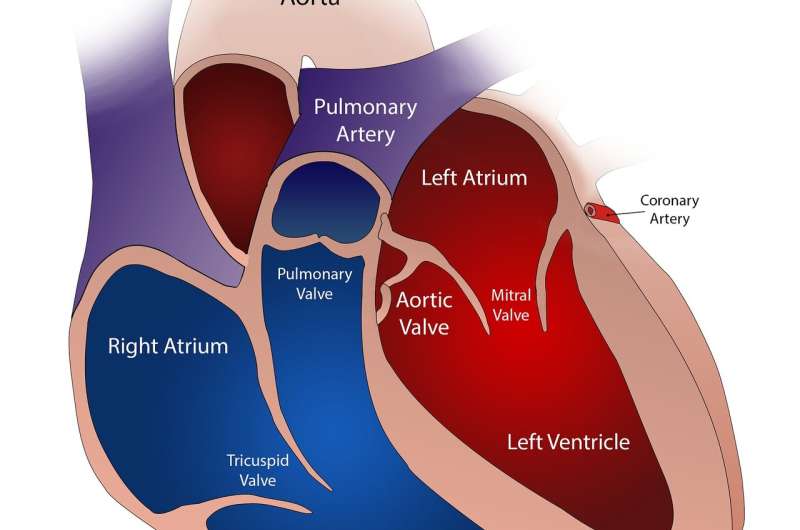Increase in CVD risk factors found among young Asian adults with atrial fibrillation

An analysis of over 1.3 million young Asian American adults hospitalized for atrial fibrillation (or AFib) found a significant, steady increase in the prevalence of obesity and other modifiable cardiovascular disease (CVD) risk factors, such as smoking, hypertension, high cholesterol levels and Type 2 diabetes, according to preliminary research to be presented at the American Heart Association’s Scientific Sessions 2022. The meeting, held in person in Chicago and virtually, Nov. 5-7, 2022, is a premier global exchange of the latest scientific advancements, research and evidence-based clinical practice updates in cardiovascular science.
“Over the last 30 years, death and disability from cardiovascular disease have been steadily rising across the globe,” said lead study investigator Nanush Damarlapally, M.B.B.S., an independent researcher in Houston. “Despite the development of advanced therapeutics and improved screening and diagnostic techniques in the last decade, there are still rising trends in the prevalence of modifiable risk factors for cardiovascular disease. This study highlights the need to address these modifiable risk factors in a younger population, since, fortunately, some of the factors that cause cardiovascular disease are modifiable, thus potentially preventing future cardiac events.”
For the analysis, researchers examined patient records from 2016 to 2019 from the National Inpatient Sample, a large U.S. insurance database. They analyzed hospitalization data for over 1.3 million Asian Americans, ages 18–44 years, who were admitted to the hospital for atrial fibrillation, which is an irregular heartbeat (arrhythmia) that can lead to blood clots, stroke, heart failure or other heart-related complications. The researchers specifically examined increasing trends in the prevalence of modifiable CVD risk factors, including Type 2 diabetes, obesity, high cholesterol, smoking and hypertension among the patients over the three-year timeframe.
The analysis found that from 2016 to 2019:
- The prevalence of obesity increased more than any other risk factor, from 6.0% to 7.8%;
- The prevalence of Type 2 diabetes increased from 10.1% to 11.4%;
- Diagnoses of hypertension increased from 7.3% to 8.1%;
- The prevalence of smoking rose from 6.1% to 6.9%; and
- The prevalence of hyperlipidemia (high levels of cholesterols and triglycerides) increased from 3.3% to 4.0%.
The authors also assessed the prevalence of CVD risk factors by sex and compared the prevalence of atrial fibrillation diagnoses among the young Asian American adults group with cardiovascular disease risk factors to adults hospitalized for atrial fibrillation who had no cardiovascular risk factors. Young Asian American adults who had at least one cardiovascular risk factor (hypertension, Type 2 diabetes, smoking, obesity or high cholesterol levels) were at an almost three times higher risk of being hospitalized for atrial fibrillation compared to young Asian American adults who did not have any risk factors.
The findings also indicate:
- 85% of the Asian American adults ages 18-44 hospitalized with atrial fibrillation were female;
- There has been a 0.4% rise in the rate of hospitalizations due to atrial fibrillation among both females and males from 2016-2019;
- The increased prevalence of risk factors was more pronounced in young Asian men (2.1% increase in obesity and 1.7% increase in hypertension) than in young Asian women (1.7% increase in obesity and 0.4% increase in hypertension); and
- The prevalence of young Asians being hospitalized with atrial fibrillation increased from 1.4% in 2016 to 1.8% in 2019 among the adults with at least one cardiovascular disease risk factor.
“We found the prevalence of obesity was higher in both sexes,” Damarlapally said. “This is in accordance with the fact that obesity has emerged as a major U.S. health problem in recent years. Most of the cardiovascular disease risk factors we examined are conditions that may affect people for a lifetime and may also impact their quality of life and other health outcomes. The risks reported here may appear small, however, on a national and international scale, these numbers likely translate into millions of people with cardiovascular disease. We need to realize this now and ensure we are prepared and ready to address the needs of these people through prevention and management strategies.”
The study authors also suggest that future research should focus on the ideal methods to identify, diagnose and treat young Asian American adults to improve cardiovascular disease outcomes.
The study’s limitations include that the researchers did not have access to patient follow-up, laboratory blood work results—such as blood sugar levels, lipid profiles and metabolic panels—or medication history because it was a review of an insurance database.
“The study findings are consistent with evidence that the burden of AFib is increasing in the United States, in parallel with a growth in prevalence of risk factors,” said Janice Y. Chyou, M.D., FAHA, a cardiac electrophysiologist in New York, an assistant clinical professor at the Icahn School of Medicine at Mount Sinai and a member of the American Heart Association’s Council on Clinical Cardiology. “This abstract joins a growing body of literature compelling our attention to cardiovascular disease risk factors.”
Source: Read Full Article
